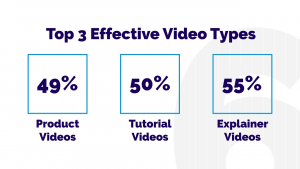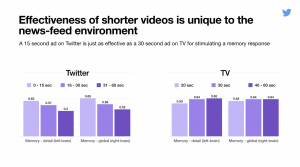Do you know that people spend an average time of 5 years and 3 months on social media in their lifetime? That’s like climbing Mount Everest 32 times and walking your dog 93K times!
In a recent study from eMarketer, there was a 70% increase in the use of all Facebook apps during the last few months. The study shows that consumers are using these apps to keep themselves entertained, connected, and informed while they’re spending time at home or on the go. Brands focus on social media for spreading awareness, driving engagement and increasing sales.
Consumers use different social media platforms for different types of content. For example, TikTok and Snapchat are mostly used for fun and entertainment while Facebook keeps people updated with the latest news and developments. That is why a number of businesses or brands are on different social media channels to connect with their audience and promote their products or services.
WHAT ARE THE LATEST MARKETING TRENDS TO FOLLOW ON SOCIAL MEDIA?
To succeed on social media, it is of utmost importance to stay ahead of the competition and understand and apply the latest trends in marketing strategies. Some trends that need to be followed by brands and adopted for everyday practice include –
Video marketing
A picture says a thousand words and a video tells a million. Through video marketing, brands can tell their story in a more engaging, entertaining, educational and inspiring way which will have a long lasting effect on the audience. The most-shared content on social media are both long-form and short-form videos. According to a report, YouTube ranks second in terms of active users only to Facebook, whereas Instagram is introducing IGTV “landscape” videos. Brands now have to take up the opportunity to produce relevant and interesting video content and also learn how to repurpose video content from other platforms to keep their audiences engaged.
Stories are gaining more popularity
Over 400 million people use Stories on Instagram daily. Similar to Instagram Stories, Facebook Stories are user-generated slideshows and video collections that are around 20-seconds video content that can be easily created on smartphones and are available for a time-span of 24 hours. For brands, interactive Stories and polls are brilliant ways to go back and forth with their audience, making their content a “must see.” Moreover, with Instagram’s new business features which includes “Growth Insights” and “Stories About You,” brands should expect to gain even more from Stories in 2020.
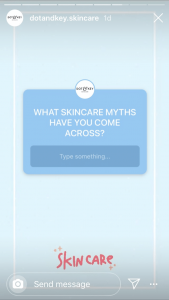
Niche Marketing
People are becoming frustrated with the over-saturation of content on popular social media platforms. Hence they are trying to move towards platforms that help eliminate the noise and posts that are irrelevant to them. Niche networks like Behance, BlogHer, BurdaStyle, Care2, Dogster, Goodreads, Dribble and more. provide brands with the opportunity to connect with a highly targeted and engaged community. Once brands are connected with their audience, they have the opportunity to know them – how they think and act which in turn can help build meaningful and close relations with them.
Niche social networks are smaller and serve only those who want to be there which means going niche allows brands to focus on their communication more precisely. They won’t have to worry about beating any Facebook-like algorithms, so brands can increase the ability to get their content seen by their relevant target audience.
Continued evolution of messaging apps
Did you know that most users, especially millennials, use social messaging apps like WhatsApp, Messenger, Viber more than actual social media itself? The Messenger app of Facebook is used by approximately 1.2 billion people and more than 2 billion messages are sent between businesses and people on Messenger each month. With the increase in the usage of social media messaging platforms, the potential for improving customer experience will expand exponentially.
The amalgamation of messaging apps with chatbots powered by artificial intelligence (AI) will make it possible for businesses or organisations to engage in more relevant, personalized and supportive customer conversations at scale.
Micro-influencer marketing
In the recent past, influencers on various social media platforms have become a major trend. However, macro-influencers with their millions of followers charge a hefty amount and are out of reach for many small and medium-scale businesses. This is why, for influencer marketing, there is a rise of micro-influencers with a limited number of followers but a more engaged community.
Opting for a micro-influencer with an engaged community and less number of followers, new or upcoming brands will not only be increasing their chances of achieving stronger engagement, but they will also be cutting their overall cost of promotions. The saved budget could be used to promote their products and services with multiple micro-influencers, in different vertices, with different niche audiences thereby making the connections more relevant and creating brand awareness.
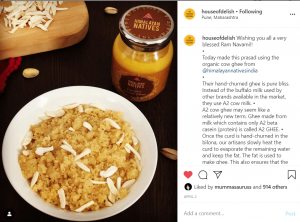
WHAT ARE THE BEST SOCIAL MEDIA PRACTICES FOR CAMPAIGNS?
For driving high revenue performance, social media campaigns can prove to be a powerful technique. However, creating a successful campaign requires knowledge of not only the fundamentals in advertising but also the necessary requirements of social media. For capitalization of businesses, driving engagement is vital for growth. It is important for brands to follow best practices to keep the audience engaged and invested to convert into loyal customers.
Frequent posting
A brand is likely to lose on the number of followers with a decreased engagement rate if they are not posting content on a regular basis. By posting real-time updates like Insta stories, Facebook live-streaming, live-tweeting and more will also help ensure that a brand’s social media account is active. While publishing regularly, brands should also post real-time events and holidays to reinforce their relevancy and up-to-date branding while keeping in mind their connection with the audience.

Relevant creatives
According to a report, audiences respond best to visuals because they tend to remember 80% more of what they see than read. Hence for a brand, it is important to make their visuals look fresh, bright and relevant, with high-resolution images and non-copyrighted photos. The dimensions of the creatives should be as per the requirement of different platforms. Poor sizing may make high-resolution images look pixelated. Errors related to visual quality or dimensions on social media will have a negative impact on the trustworthiness of a brand, thereby leading to a loss in the number of followers and low engagement rate.
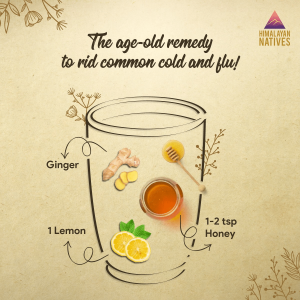
Another important mention, using videos usually have a stronger impact on the audience as videos outperform static images 9 times out of 10 on social media. Also, brands should remember to follow the 20% text rule for creatives that are used to run social media ads or boost posts.
Post boosting
Less than 10% of Facebook followers are able to view a brand’s post organically on their news feed. Hence to increase the visibility rate of a post on their audience’s news feed, brands should boost or promote the posts on their desired social media channel. The target audience can be selected as per geographical area, age, gender etc. Boosted posts optimize post engagement which eventually increases brand awareness and the number of likes, comments and shares on the posts.
Conversion Ads
Conversion ads are targeted to a brand’s target audience who are likely to click and convert. This kind of campaign is most effective when brands want to track sales or generate leads from form completions on their website. Due to its trackability feature, a conversion campaign is extremely beneficial. From video views to engagement to clicks and finally sales, everything can be tracked.
WHY SHOULD BRANDS EXPAND THEIR HORIZONS ON SOCIAL MEDIA?
It is now the era of experimentation as the online audience is always on the lookout for something new, something interesting, something that they have never seen before.
Brands should take stands
It may be risky for brands to take a stand on social and political conversations openly on social media platforms but young consumers tend to be more inclined and welcoming towards brands that take a stand. Consumers want to hear from brands that converse in intelligent, quirky and impactful ways. According to research, a majority of consumers feel that it’s important for brands to take a public stance on leading social and political issues.
Recognizing other brands
Recognizing a brand on social media can often seem to be risky as interacting with them might give them the maximum advantage to connect to a brand’s network of audience. On the flip side, it may also mean one brand leveraging the network of another brand along with highlighting its product or service USPs.
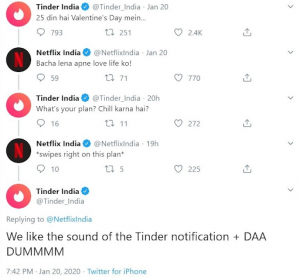
image credit: Social Samosa
As brands strategize about how to best use social media to engage with consumers, they’re also increasingly engaging with each other. Whether the banter is friendly or sarcastic in tone or manner, the main thing is to capture some recognition for being quick and witty and grab attention as well as gain followers on social media platforms like Twitter.
WHY SHOULD BRANDS USE HASHTAGS ON SOCIAL MEDIA?
Hashtags have become a social media phenomenon and a powerful part of online marketing strategies. It is easy to create them and are also searchable, thus making it an essential tool for brands, businesses, celebrities and even common individuals. If used correctly, hashtags can drive large conversations and help audiences dig deeper into a topic. Understanding the target audience and which hashtags they follow are a key to a successful hashtag strategy.
Expand organic reach
Hashtags are extremely important for social media platforms like Instagram, Facebook and Twitter since they help gain visibility on these channels. With the help of hashtags, brands can reach more number of audiences organically and can also keep a track of the reach and engagement figures. It also lends an attractive look to a social media post and encourages the audience to like the brand or page for more updates.
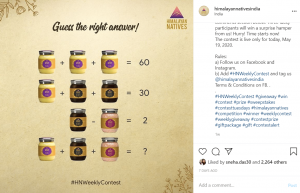
Better click-through rates
According to research, tweets or posts consisting of hashtags receive more engagement than the ones without hashtags. Hence brands can boost their customer engagement rates and click-through rates by simply adding hashtags to their posts. But at the same time, brands should refrain from using too many hashtags in a single post since it may look more like spamming and therefore weaken the meaning of the original message.
Increase visibility and brand awareness
Using a hashtag strategy to its utmost advantage to promote branding is an impressive idea. If a brand is new, hashtags can be utilized to increase audience reach and brand awareness. When users look for a brand, they’ll see the relevant hashtags that the brand is using; or when they search for specific hashtags, the brand’s posts will be visible in the results. This automatically helps the brand gain new followers and eventually potential customers.
Promotions
Hashtags are a social media version of the “word-of-mouth” method. It increases visibility by encouraging followers to use the campaign hashtag, which is further used by their followers and the cycle continues. When promoting an event, contest or giveaway, hashtags help connect a brand with its followers and also their followers with each other. The traction a hashtag can promote before, during and after an event is indeed substantial.
WHAT ARE SOME POF THE TIPS FOR RUNNING SUCCESSFUL CONTESTS ON SOCIAL MEDIA?
Contests on social media are an easy and interactive way to gain new followers, increase engagement for your brand, boost organic promotion and convert leads into customers. Moreover, it is also a wonderful idea to make existing customers happy while turning them into loyal fans and advocates of the brand.
While running a social media contest –
- Have a clear objective
- Choose single/dual but relevant platform
- Decide on the type of contest
- Set clear contest terms and conditions
- Focus on the time-span of the contest
- Promote and monitor the contest
- Acknowledge the audience’s replies
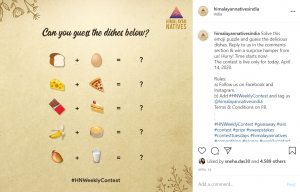
Social media is continually evolving. Every year, starting from algorithm updates to emerging trends shapes and informs the myriad ways brands interact online. Brands need to plan their social media marketing, campaign strategies, contest formats along with expanding their horizons and taking risks. Brands need to consider how they can implement some or all of the above mentioned points for online marketing. To know more about social media and how it can help boost your business, leave us a message and we will get back to you!
“81% marketers are known to use video for their marketing.”
Video is an engaging and versatile content format that is easy to consume as well as share across different social media platforms. The audience prefers it because it’s entertaining and interesting, whereas marketers believe it has a high ROI.
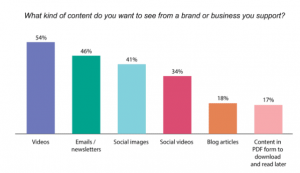
Source: Hubspot
From being a single marketing tactic, video marketing has now transformed into a holistic business strategy which is also shaping the future of sales and customer services.
Benefits of Video Marketing:
Here are the top 5 reasons why brands need video marketing –
1. Social media users love videos
Research says that 48% of social media users are likely to share video content over any other form of content with their friends if they like it. Therefore, if the aim is to increase visibility and shareability, videos should be an integral part of your strategy.
Opportunities in videos are on a constant rise on social media platforms like Facebook, Instagram, Twitter, LinkedIn, etc from GIFs, short-format videos to stories, live videos, and even virtual reality. These flexible options allow marketers to decide on the best distribution method to reach their target audience.
Live videos on Facebook, for example, get 6 times more engagement and interactions compared to regular videos, the reason why prompt discussions or celebrity tie-ups mostly happen through live videos. Twitter and Instagram videos play automatically in the newsfeed, making such posts more eye-catching and engaging.
2. Mobile and videos make the perfect combination
“65% of video content is consumed on mobile networks in India.”
With more and more people accessing video content on mobile, as a digital marketing service provider, you have to lay emphasis on video marketing in order to reach your audience. On-demand service platforms like Facebook Watch, YouTube and Netflix are also encouraging viewers to use their platforms more frequently while on-the-go through smartphones and tablets.
The demand for readily available and fast video content is on the rise, and social platforms keep adapting to meet consumer demands. As a marketer too, you have to adapt videos in your strategy to engage and entertain your audience.
3. Videos get more attention
“Statistics say that “a mobile video viewer is 1.4X likely to watch an ad on devices but 1.4X more likely to pay attention to branded content or ads on YouTube.”
Video ads have always been more powerful in capturing attention compared to static advertisements. It can be an innovative way to raise awareness, generate leads as well as improve ROI. Even in the case of websites, 88% of viewers will spend their time on a website with videos. Hence, if you have to make a long-lasting impression through your website, the inclusion of videos is a must.
4. Videos get you more organic traffic
It has been estimated that 82% of consumer Internet traffic will come from videos by 2021.
Research says that “brands that have a video embedded on their website are 53 times more likely to show up first on Google search results.” And it is well known that almost 75% of viewers do not go beyond the first page of search results on Google. This emphasizes the importance of videos for organic traffic.
Getting your video to rank on the search engine results page first involves adding relevant keywords in the title, video description as well as in the video (ex: narration at the start). The voice recognition software of Google picks up words in the video and determines the ranking based on keywords. Apart from that, sharing your video on all social media platforms and embedding it on all relevant places can help drive organic traffic.
5. Videos build a strong emotional connection
Building an emotional connection with your audience is what sets you apart from your competitors and helps create brand loyalty. Moreover, it is also the foundation for high audience engagement and greater ROI. Videos are one of the most effective ways to create emotional bonding while delivering your message, as audiences are more likely to recall a video they could connect with, even if it was viewed months or years ago.
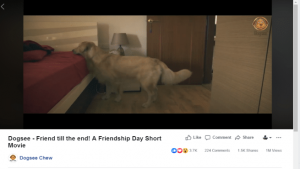
A survey revealed that 94% of the audience are more likely to recommend a brand that they have an emotional connection with, which makes videos an integral part of your marketing strategy.
Types of Video Creation by Brands
According to Hubspot, there are 12 types of marketing videos that brands can create as a part of their marketing strategy –
1. Demo Videos – To show how a product/service works.
2. Brand Videos – To show the mission/vision of a brand, build awareness and attract the audience.
3. Event Videos – A highlight of presentations or interviews from a conference, fundraiser, product launch or any other type of event.
4. Expert Interviews – Interviews and discussions with industry experts for building trust, credibility and authority among the target audience. Roping in influencers for the same through videos is also helpful in this regard.
5. How-To Videos – Can be used to teach something to the audience, whether usage of a new product or to have a better understanding of your services. Teams that work directly with customers like the service and sales departments can make optimum use of these types of videos.
6. Explainer Videos – Explainer videos help the audience understand how your product can provide a solution to their problem. It often includes a fictional journey of a customer with a certain problem and how the product/service of the business comes across as a solution to the problem.
7. Animated Videos – The most preferred format to explain an abstract service or to simplify difficult concepts for easy comprehension.
8. Case Study / Customer Testimonial Videos – Featuring your loyal customers is one of the best ways to build brand credibility. When real customers turn advocates for a product/service, the brand is more likely to get trustworthy among the target audience.
9. Live Videos – Viewers are likely to spend 8.1x longer time on a live video compared to other formats. Be it behind-the-scenes, interviews or events, live videos are a good way to get longer watch time and high engagement rates.
10. 360° & Virtual Reality Videos – 360° videos have a spherical style to enable viewers to experience content from all angles, like a particular event or location. In Virtual Reality videos, viewers have the option of navigating and controlling what they experience.
11. Augmented Reality Videos – AR videos add a digital layer to the current scene that is being recorded by the audience. Example, IKEA provides a feature where a customer can record a space at their home, and with AR, they can see if the selected furniture will suit that space.
12. Personalized Message Videos – Responding to customers or continuing a conversation with a personalized video message instead of an email or a text can also be a unique way to keep the audience interested and help them in the purchase process.
The Best Practices for Video on Each Social Platform
Creating high-quality video content is one part of the job, but you have to make sure that it fits in each social media platform to get the best results. Here are the best video marketing tips that you can follow while posting videos on social channels –
1. Facebook & Instagram
Facebook and Instagram are the two most used platforms, that mobile users especially tend to scroll in any time of the day. The silent, autoplay format works very well among mobile users. Hence, videos published on these platforms should be able to convey the meaning even without having the audio on. For example, recipes, how-to videos, easy hack videos work well on Facebook and Instagram, with or without sound.
Uploading videos directly on Facebook gives them more prominence than sharing the link from another platform. The reason being – direct upload would mean reaching out to more people.

Brand awareness videos work best on both these platforms, as the algorithm reads the past video-related history of the user to determine what to show them next. Therefore, videos have to be extremely relevant to your target audience to shoot up the engagement.
A few more tips to keep in mind are –
- The first few seconds of the video should be intriguing enough to capture the attention of the audience while scrolling.
- Visually appealing videos perform better on Facebook and Instagram compared to ones where people are talking.
- Including subtitles is a good idea so that the audience gets the complete message even without the audio.
2. Twitter
“Tweets with videos are more likely to get 6x more engagement than the ones without videos.”
Whether it’s to keep the audience engaged, promote a product or to drive traffic to a landing page, twitter videos are a great way to add a human touch to your brand and build connections. Brevity is the most important aspect of this social media platform, hence videos also need to be short and crisp, while delivering the message.
Short videos perform the best on Twitter. Additionally, pinning video tweets on top of the profile page can also help achieve more exposure. According to Twitter, brands should focus on creating videos –
- Explaining the best use case of their products and services
- The benefit of the products/services to the customers
- The social and environmental impact of the brand
- Associations with the product or the brand
3. YouTube
YouTube has more than a billion unique users per month, which makes it a highly potential platform for video marketing. However, you should always have a proper strategy in order to be successful. The questions that you should always ask yourself before posting a video are –
- Is your content specific to what your audience is looking for?
- Do you want the viewers who watch the video to land on your website?
- Is extensive brand awareness is what you’re looking for?
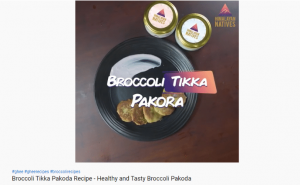
With Google owning YouTube, your brand videos can also show up on the first page of the search engine results. There are 3 things you need to keep in mind in order to rank well – keep the YouTube channel and the domain name similar, embed the shared video on your website and keep your descriptions keyword-rich.
4. LinkedIn
Initially, LinkedIn was less video friendly compared to other platforms, but brands can now upload videos and get creative here. There are 4 different themes that LinkedIn provides for video marketing on the channel –
- Showcasing tutorials of a new product or new technologies
- Industry conference or events to create the right buzz
- Teaching something new or sharing time-saving hacks
- Opinion videos on industry updates or news
Metrics for Analysing Results
Once the video has been published, knowing how it has performed is important to decide on your next course of action. Analysing the metrics helps not only in measuring the success but also in setting future goals. Here are the key metrics to be considered for video –
1. View Count
View count refers to the number of times your published video has been viewed by the audience – in other words, the video reach. If brand awareness is your goal, this metric is really important to track to see how many people have seen the content.
2. Play Rate
Play rate is calculated by dividing the total number of people who played the video with the total impressions. This metric can help determine the relevance and appeal of your videos. If you see that a lot of people have seen the video, but only a few have actually played it, that’s a sign that your content has to change.
3. Social Sharing & Comments
Social shares and comments received help determine the relevancy and popularity of the video content. If you see the audience sharing your brand video among peers, it means that the content was successful in making a positive impact. Moreover, social shares also mean more visibility and hence is an important metric to track if you want the video to go viral.
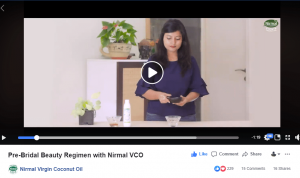
4. Video Completion
This metric measures the number of times a video is played completely and is among the most reliable ones to measure the success of your video.
5. Completion Rate
Completion rate is calculated by the number of people who watched the video completely divided by the number of people who played the video. This metric helps you understand the audience’s reaction to the video. If you observe that the completion rate is dropping after a certain time, you probably have to shorten the video length or change the content accordingly so that it resonates with the target audience.
6. Click Through Rate (CTR)
CTR calculates the total number of times your Call To Action (CTA) was clicked divided by the total number of views. With the CTR metric, you can analyse if your video was successful in encouraging the audience to take the desired action.
7. Conversion Rate
Conversion rate measures the number of times the audience has completed the action divided by the total CTA clicks. This is an important metric to measure if you have a video on a landing page where the goal is to lead the audience in completing an action.
Video is now an important part of almost every social media platform and an integral part of every digital marketer’s social strategy and campaigns. It adds a certain personality and connection to the brand – things that the audience truly wants. A well conceptualised video marketing strategy can take a brand to new heights. To know more about how video can add value to your business, leave us a message and we’ll get back to you.











